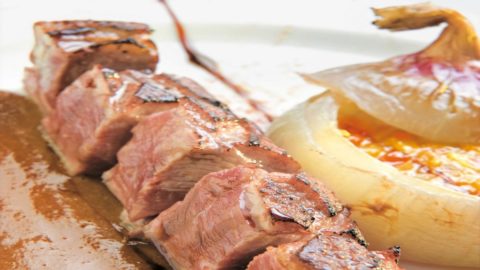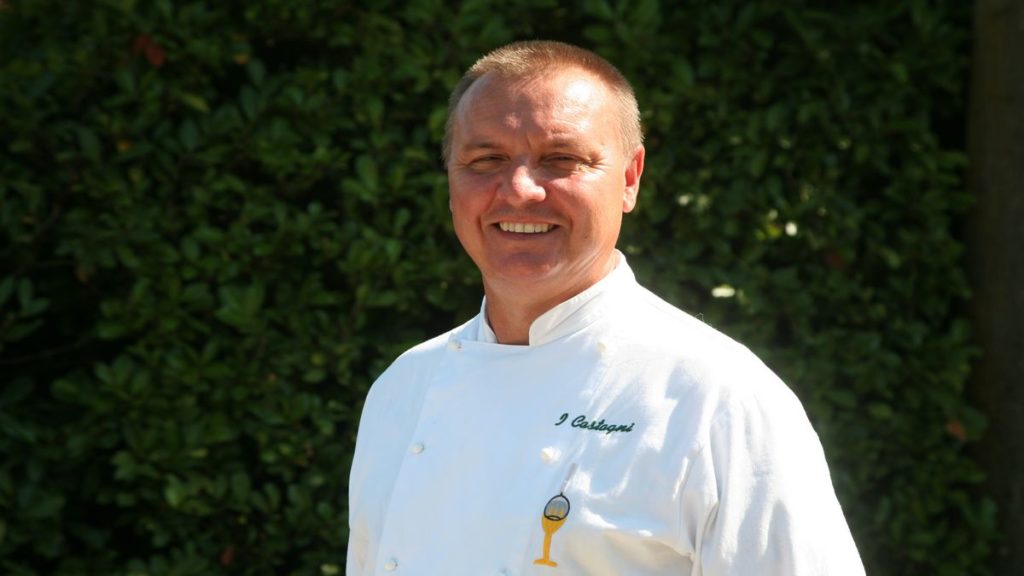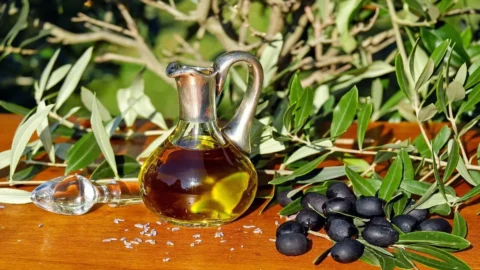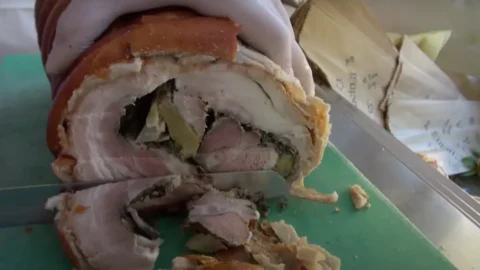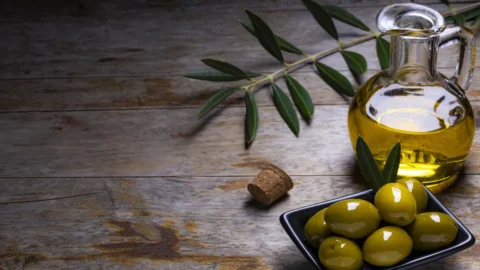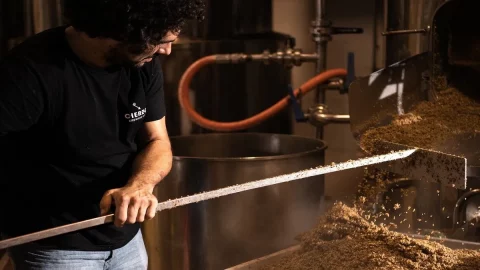Opened in 1989, housed in an old family country house, the I Castagni restaurant owes its name to the chestnut groves that populated the surroundings of Vigevano from the beginning of the 900s and, above all, to the three imposing solitary and centenary chestnut trees that still dominate the large garden of the villa.
This is the realm of Enrico Gerli, a great passion for regional and territorial resources, a cuisine that has the flavors of tradition but which the Chef then knows how to develop a very personal creative vision that aims to revitalize the culinary teachings of grandmothers with modern techniques of cooking, in order to offer the sensation of discovering new flavors where history and tradition live in its dishes.
The structure of the restaurant was a family villa and the aim was to recreate that atmosphere in the dining room, where his wife Luisa reigns instead, with a rustic-elegant décor which is the hallmark of his kitchen: antique furniture and canvases on the walls (the history) together with paintings by modern and contemporary painters, above all from Lombardy (modernity). The inspiring philosophy is that: "the customer must find himself in a house of friends who try to do their best both in the kitchen and in the dining room to make that moment a special moment".
He likes to define himself as "one of the many self-taught Italian haute cuisine who has transformed a passion for both wine and cooking into a profession - Chef Gerli - one who, having set off on the restaurant adventure without knowing what a gastronomic guide was, he found himself in a much more demanding and rewarding working and professional dimension than the one he actually aspired to”.
A journey that started from solid foundations such as the experiences at the Cascina Bovile restaurant in Ceretto Lomellina with chef Luigi Perotti mentioned by Luigi Cambi in "101 trattorias and inns in Milan where to eat at least once in a lifetime" who talks about it in these terms : “After a dinner in this place you can say that you have touched the soul of a certain Milan and if you like, look for a bowling green nearby and you could immerse yourself completely in the part. Perhaps bringing with you a quarter of Barbera to deceive you that the era of the Tranis has never ended. Letting the Darsena dei Navigli cradle your little dreams and happy thoughts”. Which was then consolidated with two big names of the most aristocratic cuisine of Italian excellence such as the Antica Osteria del Ponte di Cassinetta di Lugagnano by Ezio Santin, one of the founding fathers with Gualtiero Marchesi of great Italian cuisine, Three Michelin stars, the restaurant Sole di Ranco by Chef Carlo Brovelli, one Michelin star, and then at the Rosalpina Restaurant in San Cassiano with Norbert Niederkopfler, three Michelin stars. With these premises and this school and with so much commitment, the "self-taught" Enrico Gerli managed to conquer – it was all too predictable – very important milestones such as the Michelin Star which has awarded him since 1998, entry into the prestigious JRE association of the Young Restaurateurs of Europe) since 1993, joining as an associate of CHIC (charming Italian chefs) since 2013.
In his restaurant, as has been said, one breathes a territorial cuisine of very personal research but with forays into regional fish cuisine and "global" cuisine with particular attention to local products such as the Gambolò cowpea, the borlotto bean of Vigevano, the onion of Breme. Just as reasoned attention is paid to freshwater fish such as sturgeon and catfish, or to farmyard animals such as goose, rabbit, pigeon.
Translated into the menu we find original and complex dishes such as Risotto with Gran Riserva Lomellina and Tohoku rice: duck, peppers, shitake mushrooms, duck base with miso; Risotto alla Certosina: San Massimo alla Certosina brown rice, skewer of breaded snails with herbs, crunchy frog legs. Among the second courses, one of his "historic" dishes stands out: the Foie gras in various forms, but also the Traditional goose leg roasted in its own fat, mashed potatoes with spring onion, foie gras escalope, salad and herbs; the Pigeon cooked in two ways: roasted thigh and wing, grilled breast, spinach and hazelnuts, preserved cherries with spices, consommé and chicken liver ravioli.
Challenging dishes to be accompanied with important wines. And the cellar, the Chef's second passion, lives up to expectations. The wine list includes entries from all the most suitable wine areas in the world (300 Italian labels, 150 foreign).
For the readers of First&Food, Enrico Gerli proposes a dish that lends itself well to a nice dinner with friends outdoors on a summer evening: grilled goose breast skewer, sweet Bream onion stuffed with itself and peppers from Voghera, goose bottom at Rosso Oltrepò. A condensation of local products, and a reminder of old traditions
La recipe: grilled goose breast skewer, sweet Breme onion stuffed with itself and Voghera peppers, goose stock in Oltrepò red wine.
Ingredients for 4 people:
For the skewer: 1 goose breast with skin, 40 g of Oltrepò Pavese Rosso, salt, pepper
For the onion: 4 Breme red onions of 150 g each, 2 large Voghera peppers (or in any case sweet peppers), sweet paprika powder, 50 g of grated Provolone cheese, butter, extra virgin olive oil, salt
For the stock: 1 goose carcass without the legs but with the wings, 1 bottle of Oltrepò Pavese Rosso, 100 g of chopped vegetables (carrot, onion, celery, parsley stalks), garlic, bay leaves, rosemary, sage, 50 g of double tomato paste, salt
To complete: balsamic vinegar, paprika, butter
Method
For the bottom:
break the carcass into pieces and toast them in a pan in the oven at 200 °C; transfer to the heat, add the vegetables and herbs, sprinkle with plenty of wine and let it evaporate; add the tomato concentrate, salt lightly, cover with cold water and put back in the oven until the liquid has reduced by three quarters. Pass the remaining liquid through a sieve; in a saucepan, reduce the remaining wine by three quarters; add the goose stock, adjust the flavor and cook until a syrupy consistency is obtained. Keep warm.
For the onion:
in a pan lined with parchment paper arrange the onions with the skin, washed and salted; cook them in the oven at 200 °C for at least one hour. Peel the peppers, remove the seeds and filaments and cut them into cubes. Cut off the top cap of the onions and hollow them out leaving only the first layer of flesh under the skin. Chop the pulp with a knife and place it together with the peppers in a non-stick pan with butter and hot oil. Add salt, add a little paprika and cook until all the vegetable liquid is used up, then add the Provolone. Fill the empty onions with the mixture and keep them warm in the turned off oven.
For the skewer:
cut the goose breast with the skin into large cubes and thread them onto 4 wooden skewers, then place them, skin side down, on a very hot iron plate; cook them for at least 3 minutes, turn them over and cook for 2 minutes, add the wine, add salt and pepper lightly; transfer the skewers to a tray and let the meat rest in a warm place.
Plating
In the center of each plate place an onion, brushed with a little butter, place the skewer on it, flavor it with the red wine sauce, and cover with the onion cap; complete the dish with a few drops of balsamic vinegar and a sprinkling of paprika.

